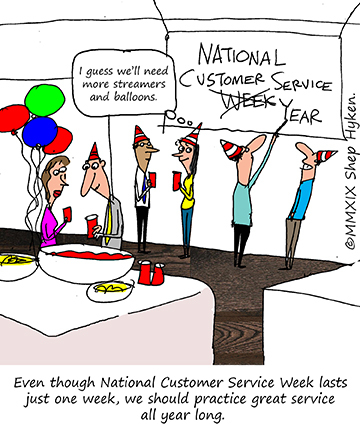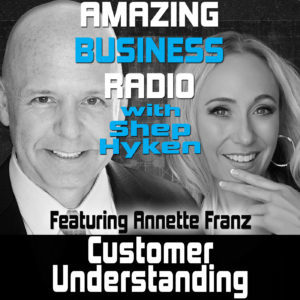Shep Hyken's Blog, page 119
September 25, 2019
5 Ways to Deliver Better Service Just in Time for National Customer Service Week
 National Customer Service Week is coming up soon. Every year it is the first full week in October. This is a week to celebrate and appreciate not only our customers, but also the people who make our customers happy. In fact, the original intent was to focus more on employees than customers, but I’m happy to celebrate both.
National Customer Service Week is coming up soon. Every year it is the first full week in October. This is a week to celebrate and appreciate not only our customers, but also the people who make our customers happy. In fact, the original intent was to focus more on employees than customers, but I’m happy to celebrate both.
In customer service, there are so many ways to do things right. In my speeches, I talk about the right way to manage first impressions, demonstrate knowledge, build rapport, ask the right questions and much, much more. I thought it would be fun to create a list of a few things that everyone should do right. These are some of the basics—they should be common sense. Since National Customer Service Week is five days long, here is a list of five simple ways to create a better experience for your customers and your colleagues at work.
The Greeting: In-person, look someone in the eye. Shake their hand firmly and with confidence. Dress for success, which means dressing appropriately. When answering the phone, don’t be gruff or short with your greeting. Warmly welcome the customer into the conversation.
Leaving a Voicemail: If you call someone and get their voicemail, you might as well leave a message. Thanks to caller ID, most of the time they will know you called, so take advantage and leave a good message. Start with your name, then immediately state your phone number. That’s the important part—giving the customer your contact info at the beginning of the message. Then leave the message and end by repeating your phone number and email, if appropriate.
Responding to Messages: This includes phone, email, social media, and any other messaging app. It’s simple—do it fast! There are different expectations for different modalities, but if you really want to be impressive, respond to your customers—especially their phone messages and emails—“freaky fast.”
An Apology: When a customer has a complaint, the first thing you want to do is apologize—in the right way. It should be sincere, but beyond that, there must be some acknowledgment of the problem. An empathy statement like, “I’m so sorry. I can understand why you’re upset. I’d be upset if that happened to me,” is a good way to apologize and acknowledge the customer’s problem quickly—in short, a perfect start to resolving the issue.
Building Rapport: What do customers like to talk about? Themselves! Take a moment to talk about them and their lives, not just business. It can be a five or ten-second interaction, but it helps break the ice. For example, say, “Where are you calling from today?” Or, “I hear a dog barking in the background. What kind of dog do you have?” If you’re talking to a colleague at work, ask about their weekend or their kids. You get the idea. There are many ways to add a little personalization to a conversation.
Now, here’s an idea to make these ideas come to life. Every day throughout the week, focus on just one of these tactics. Have each employee write down one example—just two or three sentences at most—that describes how they used this common-sense customer service tactic with an outside customer or one of their team members. Then, share these with the team.
As I like to say every year, National Customer Service Week is only a week-long, but that doesn’t mean you shouldn’t practice these tactics—and everything else customer-focused—for the entire year!
Shep Hyken is a customer service expert, keynote speaker, and New York Times bestselling business author. For information, contact 314-692-2200 or www.hyken.com. For information on The Customer Focus customer service training programs, go to www.thecustomerfocus.com. Follow on Twitter: @Hyken
customer service training programs, go to www.thecustomerfocus.com. Follow on Twitter: @Hyken
(Copyright © MMXIX, Shep Hyken)
The post 5 Ways to Deliver Better Service Just in Time for National Customer Service Week appeared first on Shep Hyken.
September 24, 2019
Amazing Business Radio: Annette Franz
 Customer Understanding
Customer UnderstandingThe Link Between the Employee Experience and the Customer Experience
Shep Hyken interviews Annette Franz. They discuss her new book, Customer Understanding: Three Ways to Put the “Customer” in Customer Experience (and at the Heart of Your Business). They also talk about the crucial role the employee experience plays in the customer experience.








The Interview with Annette Franz:
Customer understanding is a cornerstone of a customer-centric culture. You must understand who your customers are, the experience they’re having, the problems they face, their goals, and how your business helps them achieve their goals.
Communication is crucial in the customer experience. You must communicate openly and honestly with your customers, especially if you need to make changes and decisions that will affect their experience.
Everything that affects the customer experience is related to the employee experience. Use the same tools to measure and map the employee experience as you do for the customer experience. Employees, after all, are “internal” customers, and what happens on the inside of an organization will be felt on the outside by external customers.
It’s important to eliminate friction for both customers and employees. Be wary of making decisions that will eliminate friction only for customers, while creating more difficulties for employees. That friction, though not direct, will eventually be felt by the customers, too.
Happy employees result in happy customers. If you treat your employees well, they, in turn, will treat your customers well. The result is a win-win for your business.
Without customers, you have no business. But in order to have happy, loyal customers, you must treat your employees well. At the end of the day, your business focus should really be on the people that drive your business—both customers and employees alike.
Quotes:
“It’s all about the customer. If you don’t have any customers, then you have no business. But you won’t have customers if you don’t have employees to build things and service things. So, really, it’s all about the people.” – Annette Franz
“Out of a great employee experience comes employee engagement, productivity, and quality. This translates to a great experience for customers.” – Annette Franz
“Customer centricity is about putting the customer at the heart of everything you do. There should be no decisions, no discussions, no designs without first thinking about how it impacts the customer.” – Annette Franz
About:
Annette Franz, CCXP, is founder and CEO of CX Journey Inc., as well as an internationally recognized CX thought leader, coach, speaker, and author of Customer Understanding: Three Ways to Put the “Customer” in Customer Experience (and at the Heart of Your Business. Her website is cx-journey.com.
Shep Hyken is a customer service and experience expert, New York Times bestselling author, award-winning keynote speaker, and your host of Amazing Business Radio.
This episode of Amazing Business Radio with Shep Hyken answers the following questions … and more:
How can I create a great customer experience?
How can I create a great employee experience?
What mistakes do employers make with their employees?
How are the customer experience and the employee experience related?
How important is communication?
The post Amazing Business Radio: Annette Franz appeared first on Shep Hyken.
September 23, 2019
5 Top Customer Service Articles for the Week of September 23, 2019
Each week I read a number of customer service and customer experience articles from various resources. Here are my top five picks from last week. I have added my comment about each article and would like to hear what you think too.
How To Tell If A Customer Service Agent Will Help You by Christopher Elliott
(Forbes) When you’re on the line with someone like Valerie Zhou, there’s no question this customer service agent will help you.
My Comment: Chris Elliot is a consumer advocate. At first, I thought this article was written for consumers. After all, the title is “How to Tell if a Customer Service Agent Will Help You.” Then as I read it, I realized there is solid information about what makes for a great customer service agent. Perhaps the title should be “How to Tell if Your Customer Service Agents Will Help Your Customers.”
3 Ways Artificial Intelligence Is Transforming Customer Experience by Inge De Bleecker
(CMSWire) Artificial intelligence (AI) is here. The technology is already making an impact across many industries. According to IDC, worldwide spending on AI systems is forecast to reach $35.8 billion in 2019 — a 44% increase over 2018.
My Comment: I like how AI (Artificial Intelligence) has been improving the customer experience. Used the right way, it is a great aid in so many ways. This article gets to three areas that truly benefit the customer; personalized recommendations, biometric recognition and virtual (digital) assistants. I’m a big fan of these CX improvements and am excited to see how they get even better in the near future. The improvements in AI are happening so fast that it may be akin to Moore’s Law and the increased processing power of a computer.
5 Ways to Keep Happy Customers by Matt Shealy
(G2) Improving customer happiness is the key to success for any business, whether you’re selling products or providing services.
My Comment: You want happy customers? Do you want to keep your happy customers? Then read this article. The author shares five ways to keep them coming back. Content marketing, social media, customer feedback, customer support, and training and analytics… These aren’t just buzz words. These are the ways great companies are getting their customers to return again and again.
The Ultimate Guide to B2B Reviews by Sarah Fraizer
(CustomerGauge) Learn the benefits and obstacles of modern B2B review management, as well as how to use your CX program to automate the review process and generate pipeline.
My Comment: Reviews are not just for consumers to rate retailers and other B-2-C businesses they frequent. There are review sites for every type of business in every type of industry. This excellent article goes into great detail about the benefits and obstacles of reviews in the B-2-B world.
3 Common Errors That Can Render Your Customer Journey Maps Ineffective by Leonie Brown
(Forbes) We’ll look at three common errors that could be derailing your company’s efforts at customer-journey cartography.
My Comment: Journey maps are an important exercise for virtually any organization to go through. It’s worth the time and effort to identify the touchpoints a customer has with your organization and how you can improve them. And, there is a right way and a wrong way to go about it. This article points out three common mistakes that, as the title indicates, can render your journey map effort ineffective.
BONUS
Don’t Diss the Tech: Best Uses of AI in Customer Service and How Attitudes Toward AI Have Changed by Cassandra Vincent
(Navedas) Building on our article, Human and Machine are Best Together, I wanted to discover how attitudes toward AI have changed. I connected with respected pros in the sector for their thoughts and best uses of AI in customer service.
My Comment: As you can tell from my comment in the second article of this week’s “Top Five” list, I’m a fan of AI. I wanted to add this “bonus article” as it includes my response to a question about the effective use of AI in customer service and experience. It also includes a comment from my friend, Jeremy Watkin, who has been in the customer service “trenches” for years.
 Shep Hyken is a customer service expert, professional speaker and New York Times bestselling business author. For information on The Customer Focus
Shep Hyken is a customer service expert, professional speaker and New York Times bestselling business author. For information on The Customer Focus customer service training programs go to www.TheCustomerFocus.com. Follow on Twitter: @Hyken
customer service training programs go to www.TheCustomerFocus.com. Follow on Twitter: @Hyken
The post 5 Top Customer Service Articles for the Week of September 23, 2019 appeared first on Shep Hyken.
September 20, 2019
Guest Blog: Why cross-team collaboration is essential for B2B customer support teams
This week we feature an article by Robert C. Johnson who writes about the importance of cross-team collaboration when providing B2B customer support.
Simply put, B2B support is significantly different than B2C support. A stand-alone customer support group can’t handle 100% of the issues they receive in the B2B industry. These issues are usually more complex, involving several internal stakeholders and requiring a larger, more advanced and specialized team to address them.
Forming this team is a unique process for each business, and making the right decisions on who to include is vital for working together efficiently. With more B2B companies choosing support software technology as their “hub” for all customer communication, it’s important to determine what departments need access and why.
Here are a few of the more common departments outside of support that can assist in resolving customer issues or can obtain immediate value from customer conversations:
Product Management – This team can not only inform agents of upcoming features and functionality in private (internal) ticket actions directly within the software, but they can use customer information for planning purposes. By monitoring the frequency of feature requests and bug report tickets, it lets them create a realistic product roadmap for meeting customer demands.
Customer Success / Account Management – Outside of support, this team interacts with customers the most frequently. Because of this ongoing dialogue, it’s important they know what issues a customer is having so they can be prepared for their next “check-in” call. If they see a customer is having problems with chat conversations, they can provide training on their next call around configuring the chat technology to ensure its meeting their needs.
Product Creation and Development – Too often in the B2B software world when a support agent doesn’t know the answer to a question, they pass it on to a developer who attempts to respond with limited information. As a result of this process, many companies have decided to provide development team members with licenses to support software. By having access to this technology, they can better understand the customer issue and thus provide a better fix.
It’s also not uncommon for other departments such as Sales, Onboarding, and Marketing to have access to support software as well. However, in many cases providing all these team members with licenses to the software is just the first step in achieving cross-team collaboration.
Remove silos between teams and encourage cross-team collaboration
We’ve outlined the departments that work together, but how exactly do companies achieve cross-team collaboration? Most B2B companies have an “old school” mentality related to how they work and who they work with internally. The key is to leverage technology to break down these dated silos. Integrating B2B customer support software with other internal systems is one way to encourage the real-time sharing of information between departments. Teams should integrate support software with development tools, sales tools including CRM technology, and marketing communication tools. Establishing these integrations means departments can easily share relevant information about customers with minimal effort, reducing duplicate and outdated information across all systems.
For example, if sales updates information about a customer contact in a CRM system, that information will be pushed to the support software so both teams have the most relevant data. Walk in your customer’s shoes for a moment. Pretend your main contact at a key customer just got a promotion. They told your VP of Sales who updated their contact info in the CRM and its fed elsewhere via integrations. Now, watch as the “congratulations” messages come flying in from multiple colleagues in different departments over the next couple weeks! This is just one way businesses are taking a smarter, data-driven approach to support information to keep customers happy.
Support teams also need to feel empowered to share key information they’ve learned with colleagues throughout the entire company such as product, sales, IT and marketing. One way to do this is by creating content on an internal collaboration solution. Some customer support software solutions have these built in, while other options can include an internal Wiki, blog, or Slack channel. While automated data integrations are great, it’s tough to replace the great ideas that happen in these company-wide conversations.
Managing tickets as a unified support team
There are several different ways to obtain actionable information from other departments. The next step is being able to take this information and apply it in an efficient manner to everyday support interactions. Doing this successfully will not only empower your support team to make better decisions, but it will also fuel more cross-team collaboration.
Colleagues want to know that the cross-team information they are providing the support team isn’t being ignored. Encourage the support team to take the information they’ve learned about a customer and log it in support software to show they’re using shared information. For example, if an onboarding specialist tells a support agent that a new customer has “half-day Fridays” during the summer, they can create a notification that pops up for any software user when they view the company profile. This way, if an agent in a different country is working on a time-sensitive ticket, they’ll know to prioritize it and get a response back before everyone leaves the office. This information can also benefit other departments. If a sales manager is looking to upsell the customer on a new feature, they’ll click on the company profile and know immediately that Friday probably isn’t a good day for a meeting.
Cross-team collaboration is essential for B2B support teams because it makes a big difference for the entire company. Everyone within a company has the same goal; to keep a customer happy and ensure they stick around. Companies that don’t lose sight of this and leverage technology and conversation to reach it will only put themselves in a position for continued success.
Robert C. Johnson is the co-founder and CEO of TeamSupport.com, a cloud-based, B2B software application built to help customer-facing support teams serve clients better through stronger collaboration, superior teamwork, and faster issue resolution. A seasoned executive and entrepreneur who has founded and invested in numerous software and high-tech companies, Robert’s industry experience as a business leader and a customer-inspired him to create TeamSupport to give Support Desk teams the tools and best practices to enhance customer loyalty and positively impact product sales.
For more articles from Shep Hyken and his guest contributors go to customerserviceblog.com.

Read Shep’s latest Forbes article: Convenience Meets Community: Kroger Rolls Into Neighborhood With Mobile Grocery Stores
The post Guest Blog: Why cross-team collaboration is essential for B2B customer support teams appeared first on Shep Hyken.
September 18, 2019
Yes is More Than an Answer. It’s an Attitude!
 Customers don’t like to be told no. Any request or complaint that is met with a negative response may only add fuel to the fire. That’s why I’ve been intrigued for years by Cameron Mitchell’s philosophy—and also the title of his book—Yes is the Answer! What is the Question?
Customers don’t like to be told no. Any request or complaint that is met with a negative response may only add fuel to the fire. That’s why I’ve been intrigued for years by Cameron Mitchell’s philosophy—and also the title of his book—Yes is the Answer! What is the Question?
Why did I wait so long to write about this? I have addressed this topic in several other ways. For example, one of my favorite business strategies is “one to say YES and two to say NO”, which is all about empowering employees to say “yes” to customers. What made me want to write about Cameron Mitchell’s concept now is that I recently had the opportunity to interview Cameron and learn directly from the “Master of YES” himself.
Cameron Mitchell is the founder and CEO of Cameron Mitchell Restaurants. There are about sixty of them and they are recognized for great food and great service across the board. As one might imagine, in the restaurant business you get all types of special requests. It would be very easy to say no to a customer for many of these special requests, but Cameron has a different philosophy.
First, Cameron emphasizes the idea that saying yes is philosophical. There are plenty of reasons you might say no to a customer, so you must train your people accordingly. Obviously, you must say no to anything illegal. For example, a sixteen-year-old at a restaurant is not allowed to order alcohol. But you can start with the idea that everyone should try to say yes. Then, through training, give employees examples that show them how far they can go. That’s a good way to start embracing the “yes” attitude.
And “yes” really is an attitude. It must be baked into the culture of an organization. Employees must be empowered to say yes whenever possible or to find creative solutions to make customers happy when the answer must be no.
If an employee asks permission for something they weren’t sure they could say yes to, then that should be the last time the employee should ever have to ask permission for anything similar. Document those examples for others to follow. Train by citing examples of actual interactions between employees and customers. By the way, if someone crosses the line and doesn’t say no when they should, that is a great training opportunity as well.
“Yes” is more than just a simple answer to a customer’s request or needs. It’s an attitude and a culture. Create an organization focused on taking care of the customer—this could mean saying yes or coming up with other ways to make the customer happy. Serve your customers with the “yes attitude,” and they’ll serve you success for your business.
Shep Hyken is a customer service expert, keynote speaker, and New York Times bestselling business author. For information, contact 314-692-2200 or www.hyken.com. For information on The Customer Focus customer service training programs, go to www.thecustomerfocus.com. Follow on Twitter: @Hyken
customer service training programs, go to www.thecustomerfocus.com. Follow on Twitter: @Hyken
(Copyright © MMXIX, Shep Hyken)
The post Yes is More Than an Answer. It’s an Attitude! appeared first on Shep Hyken.
September 17, 2019
Amazing Business Radio: Paul Selby
 Customer Service Will Never Go Out of Style
Customer Service Will Never Go Out of StyleKeeping Customer Service Relevant to Self-Service and Proactive Service
Shep Hyken interviews Paul Selby of ServiceNow. They discuss the evolution of customer service and customer needs in a digital world, and how companies can employ self-service and proactive service to meet customer demands.








The Interview with Paul Selby:
Self-service is all about empowering customers and giving them the ability to solve their own problems. This often allows resolutions to be reached faster, which makes the customers happy and eliminates extra work for customer support agents.
Most of today’s customer service is reactive instead of proactive. Proactive service is about being aware of your customer’s world anticipating problems, and solving them before the customer has a chance to contact you. The goal is to be so good that no one ever has to call customer service.
Even if the issues that arise are not your fault, you still need to provide your customers with access to you for support.
Despite some customers’ and companies’ preference for AI and chatbots, voice-to-voice (as in, human-to-human) interface remains the fastest and most frictionless way to provide that support. Technology is not yet at a place where it can include and convey empathy in its responses.
At the end of the day, customers drive every aspect of a business. Therefore, it is crucial that you focus on creating genuine, authentic connections with your customers.
Customer service is a part of and encompasses all other departments. Make sure you train and empower all employees to deliver the best experience possible.
Quotes:
“We’re always expecting more as human beings. Customer service will never go away; there will always be a need for it.” – Paul Selby
“Customer service is ground zero for making the customer experience better.” – Paul Selby
“Feedback is a huge opportunity for insight. Build your culture around that.” – Paul Selby
About:
Paul Selby is a product marketing director for Customer Service Management at ServiceNow.
Shep Hyken is a customer service and experience expert, New York Times bestselling author, award-winning keynote speaker, and your host of Amazing Business Radio.
This episode of Amazing Business Radio with Shep Hyken answers the following questions … and more:
What is proactive service?
What is the difference between proactive service and self-service?
How do I balance AI with human support?
How do I create a customer-focused culture?
How does customer service stay relevant and important (in the face of AI)?
The post Amazing Business Radio: Paul Selby appeared first on Shep Hyken.
September 16, 2019
5 Top Customer Service Articles for the Week of September 16, 2019
Each week I read a number of customer service and customer experience articles from various resources. Here are my top five picks from last week. I have added my comment about each article and would like to hear what you think too.
Delta Just Gave A Simple, Stunning Explanation For Why It’s Successful (And Why American Airlines Isn’t) by Chris Matyszczyk
(Inc.) A few basic, thoughtful decisions can contribute to lasting success.
My Comment: Full disclosure: I do most of my flying on American Airlines. This article does a little AA bashing, and I can see the point, but what the author writes about Delta is well worth studying – and even emulating. By the way, I also fly Delta and I can’t argue what this author’s view on how well Delta has managed both the employee and customer (passenger) experience.
Seven Ways To Improve Customer Service by Sara Lavenduski
(ASI) An excellent customer service experience will lead more naturally to a close.
My Comment: I like lists. Here are seven customer service ideas. While there is a lot of common sense here, pay close attention to number six: Look at B-2-B as P-2-P. (That’s Person-to-Person.) It’s all about building relationships.
Building a Robust Customer Experience Management Strategy: Lessons From Nike by Vandita Grover
(MarTech Advisor) Customer experience management is how a brand builds and grows relationships with their customers and creates consistent, meaningful, and enjoyable interactions at different stages of the customer journey, across channels and touchpoints. Brands like Nike have been successful in understanding their customers over the years to create enhanced and seamless experiences.
My Comment: Nike is one of my favorite companies to learn from. They are one of the best companies on the planet when it comes understanding their customers; their interests, buying habits, etc. So, when I see an article about Nike’s CX strategy, I take notice… And you should, too!
Six Tips for Creating a Stellar Customer Experience on Multiple Marketing Channels b y Chanell Turner
(CBT) How can you create exceptional omnichannel customer experiences that help to guide potential car buyers to purchase? Check out our tips below to help you get started.
My Comment: Even though this article focuses on automotive dealers, there are lessons here for every type of business. The ideas are centered around different channels your customers may use to interact with you – and how understanding how they communicate is paramount to a good customer experience. My favorite strategy is number three, which is about creating buyer personas. Every business, large or small – and from any industry – needs to understand the different types of customers that do business with them.
Why Spirit Airlines’ and Ryan Air’s Customer Experience is Better than Yours by Jim Tincher
(Heart of the Customer) When a friend heard we were flying Ryan Air, she told me, “Uh oh. Pay attention to the experience you receive.” Interested, I did pay attention. And I realized that Ryan Air probably has one of the better CX programs out there.
My Comment: We started this week’s roundup with an article about Delta Airlines. Let’s “bookend” the list with another airline article. This one is about Ryan Air and Spirit, recognized as the extreme low-cost carriers with no frills and up-charges for everything; baggage, assigned seats, carry-on luggage, etc. Their focus on what they will offer the customers creates a very specific expectation. And while that may not work for other airlines, it works for them. The author includes a comment about Southwest Airline’s strategy as well.
 Shep Hyken is a customer service expert, professional speaker and New York Times bestselling business author. For information on The Customer Focus
Shep Hyken is a customer service expert, professional speaker and New York Times bestselling business author. For information on The Customer Focus customer service training programs go to www.TheCustomerFocus.com. Follow on Twitter: @Hyken
customer service training programs go to www.TheCustomerFocus.com. Follow on Twitter: @Hyken
The post 5 Top Customer Service Articles for the Week of September 16, 2019 appeared first on Shep Hyken.
September 13, 2019
Guest Blog: 7 Ways to Enhance Your Customer Experience with Live Chat
This week we feature an article by Hamzah Tariq who shares seven ways to improve the overall live chat experience for your customers.
Businesses constantly try to improve the customer experience they deliver through new approaches, tools and strategies.
One of the most successful ways to enhance the customer experience is through live chat. However, there’s always room for improvement in how customers are engaged via chat.
Here are 7 areas we feel are extremely important when it comes to improving the overall live chat experience delivered to customers.
Be quick to accept live chat requests
Don’t make customers wait when they initiate live chat requests. Both customers and prospects value personal and instant means of interaction and the longer they wait the higher the chances of them going to a competitor
 Live chat response times in seconds – Statistica
Live chat response times in seconds – Statistica
Consumers compare your live chat response times with the best service they’ve experienced – regardless of industry. Keeping in mind industry averages, aim to respond to incoming chat requests in around 30 seconds as that would put you in the top 5% in terms of response times.
Be Confident and knowledgeable
Always be sure of the advice you’re giving. You could be answering a prospect who has questions about a product, or a customer requiring technical support. In any case, your response should be quick, confident and thorough. Do not take any shortcuts and make sure you know what you’re talking about.
Be sure of your answers
You’re not going to have answers to every question all the time. In the event you’re lacking the knowledge required to respond to a query, take the time to research the topic and find the best possible answer.
In a survey conducted of 400 consumers and 100 businesses, 95% of respondents said they would prefer slower support if it meant the quality of help was higher.
There’s nothing worse than a half-baked reply. So be sure to reference your knowledge base or engage an expert at your organization. Be sure to let the customer know that you’ll be stepping away for a few minutes so they know what to expect. If you need more time, let them know you’ll be getting back to them and be sure to gather as much information as possible so you and your team have everything needed to provide a knowledgeable response that answers the customer’s question.
Communicate clearly
Be as clear as you can when communicating with customers and prospects. Never use slang, abbreviations or acronyms that someone outside of your organization may not understand. Your customer is still figuring out how to get the best value from your product or service so always remember to take the time to simplify and break down responses, to ensure everything is crystal clear.
Be friendly and approachable
No one can see you smile when you respond to a chat unless you use an emoji. Not using emojis can make you come off as clinical and unwelcoming. Customers and prospects both appreciate it when you’re genuinely happy to be speaking with them. Having a conversation sprinkled with emojis comes off as friendly and welcoming. Customers also tend to be more patient and willing to wait for a response when you make them feel comfortable and welcome.
Test the recommended solution
When delivering technical support, be sure to have tested the solution you’re recommending. If the solution has not been tested in your own environment do not choose speed over accuracy, and instead, request more time. One rushed response that ends up being wrong can frustrate a customer which in turn can negatively impact your business.
Share documentation
According to Forrester research, customers prefer knowledge bases over all other self-service channels. When responding to a query, wherever possible, provide customers with a response and couple it with a well-written knowledge base article. Pointing customers to an article equips them with the information they need to address the issue themselves. For any new issue faced, be sure to first test it in your own environment and then remember to author a knowledge base article so in future others are able to find answers to the problem without having to get in touch with someone.
Implementing these 7 live chat best practices can contribute to customer success and positive word-of-mouth, and help your business grow through improved retention and new customer acquisition.
Hamzah Tariq is a Marketing Manager at Kayako. He writes on new and improved ways to deliver customer service that lead to improved customer experiences.
For more articles from Shep Hyken and his guest contributors go to customerserviceblog.com.

Read Shep’s latest Forbes article: Ten Content Marketing Hacks To Drive A Better Customer Experience
The post Guest Blog: 7 Ways to Enhance Your Customer Experience with Live Chat appeared first on Shep Hyken.
September 11, 2019
That “Something Extra” You Offer to Make Customers Love You
 In the realm of business—and especially customer service—we often talk about how to differentiate yourself from your competition. It’s those companies that manage to stand out from the crowd that end up being successful. When I work with companies, I urge them to find what makes them unique and use it as a competitive advantage. It’s always a treat when I meet people who not only agree with my philosophies but take them a step further. That’s where Rodney Gaddis comes in.
In the realm of business—and especially customer service—we often talk about how to differentiate yourself from your competition. It’s those companies that manage to stand out from the crowd that end up being successful. When I work with companies, I urge them to find what makes them unique and use it as a competitive advantage. It’s always a treat when I meet people who not only agree with my philosophies but take them a step further. That’s where Rodney Gaddis comes in.
I met Rodney at a conference where I was speaking about customer service. Rodney is in the very competitive field of lawn care as a Spring-Green franchisee, and he’s very successful. I asked him to share a little wisdom about his success and he immediately responded with the following:
Anyone can make a grilled cheese sandwich, but can they make it like your grandmother?
I smiled when he shared that witty nugget of wisdom. I knew exactly what he meant. Anyone can do what we do, so what do we do to make it special or maybe a little different so we stand out?
Almost all business is competitive in that most of us, and the organizations we work for, sell something that our customers can most likely buy from someone else. In some cases, the business sells a commodity. There is little, if any, differentiation from one company to the next. Often, the customer chooses one company over another because of their relationship with the salespeople or employees. Or, it may be that one store is more convenient than the other. And of course, price often plays a role in this “natural selection” as well. Despite all promising more or less the same thing, there will be differences between companies.
For instance, Rodney competes with national companies, such as TruGreen, in addition to many local competitors. They all promise their customers a lush green lawn green devoid of weeds. But Rodney not only gets the business, he keeps the business, as evidenced by one of the lowest customer defection numbers in the industry.
His competition may be able to do a comparable job, but as Rodney says, anyone can make a grilled cheese sandwich. When you add the extras, like butter, salt and pepper, and even a little love… well, that’s what makes you stand out. Rodney stands out because he puts those “extras” into what he does every day. It’s about more than just doing a great job. It’s about the passion and love he puts into his profession. His customers can feel that. That’s what makes Rodney stand out to them over the competition. That’s what makes the grilled cheese… as good as your grandmother’s.
Shep Hyken is a customer service expert, keynote speaker, and New York Times bestselling business author. For information, contact 314-692-2200 or www.hyken.com. For information on The Customer Focus customer service training programs, go to www.thecustomerfocus.com. Follow on Twitter: @Hyken
customer service training programs, go to www.thecustomerfocus.com. Follow on Twitter: @Hyken
(Copyright © MMXIX, Shep Hyken)
The post That “Something Extra” You Offer to Make Customers Love You appeared first on Shep Hyken.
September 10, 2019
Amazing Business Radio with Steve Farber
 Love in Business
Love in BusinessDoing What You Love in the Service of Customers Who Love What You Do
Shep Hyken interviews Steve Farber. They discuss how to implement love into every aspect of your business to drive customer success.








The Interview with Steve Farber:
Even if you love what you do, there will still be days that feel like work. You must do the necessary things you dislike in order to be able to do the things you love in your business. Doing only what you love is called retirement—but you don’t necessarily need to be retired to feel this way.
Societally, we are unaccustomed to using the words “love” and “business” in the same sentence. Using the word “love” in relation to business raises the standards and expectations in a way that promotes positive growth. However, you shouldn’t use this verbiage if you don’t intend to follow through with it; if you talk the talk, you must also walk the walk.
We want customers to love our products and services. If they don’t, we will have no competitive advantage. Achieving this starts on the inside with the company’s culture. You must first create an environment people love working in; do it right, and this love will be felt on the outside by the customer.
A cultural focus can begin on any level of an organization and needs to happen on every level. However, you can’t create this as a leader if you don’t love it yourself first. You must love the environment you create so your employees will also love it—and then customers will feel that love too.
To kickstart your cultural change, ask yourself the important questions, like what love looks like in business, why you love what you do, and how you can show it. Then ask those around you what you can do to demonstrate customer love and implement those new ideas. Many good ideas already exist within your organization. Ask the right questions so you can have the right internal conversations.
Business, like love, is incredibly personal. This is the most important but also the most overlooked aspect of business
Quotes:
“As businesspeople, we want our customers to love what we do for them. If they don’t love the product or service, then we have no advantage at all.” – Steve Farber
“If you want your customers to love you, you have to create an environment that people love working in. The only way you can create that kind of environment is if you love it first.”– Steve Farber
“Get very vigilant and specific about putting love into practice in every aspect of your business.”– Steve Farber
“Take more concerted, intentional, conscious action to operationalize love in the way you do business.”– Steve Farber
About:
Steve Farber is the president of Extreme Leadership Inc., a speaker and consultant, and the author of several books including Love is Just Damn Good Business and The Radical Leap.
Shep Hyken is a customer service and experience expert, New York Times bestselling author, award-winning keynote speaker, and your host of Amazing Business Radio.
This episode of Amazing Business Radio with Shep Hyken answers the following questions … and more:
How can I operationalize love in my business?
How can I make my customers love me?
How can I show my customers that I love them?
How do I create a better employee experience?
How do I create a better customer experience?
The post Amazing Business Radio with Steve Farber appeared first on Shep Hyken.



